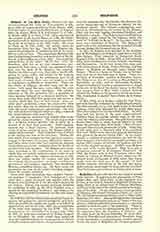

Helpidius, FLAVIUS RUSTICIUS, the name of several Latin writers. It appears in the manuscript of Pomponius Mela and Julius Paris as the signature of a reviser, in the form Fl. Rusticius Helpidius Domnulus. Julius Paris is an abbreviator of Valerius Maximus, and lived at the end of the fourth century or the beginning of the fifth. On the other hand a correspondent of Sidonius calls himself Domnulus (Epist., IV, 25; cf. IX, 13) and wrote poetry during a stay at Arles under Majorian (457-461). Among the signatures of revisers of certain manuscripts he appears as “count of the consistory”; Sidonius calls him an ex-quaestor, i.e. the rank superior to that of count of the consistory. There is, therefore, no reason for distinguishing the author of the signatures from the Domnulus of Sidonius. On the other hand the deacon Helpidius (d. about 533), friend of Ennodius and physician of Theodoric, King of the Ostrogoths, is unquestionably another person. Under the name of Helpidius, the “former quaestor”, we have twenty-four strophes of three hexameters each, on scenes from the Old and New Testaments. Sixteen of these scenes correspond to one another, e.g. as type and fulfilment. These verses were probably intended as texts for the decoration of a church. Under the title of “Rustici Elpidii carmen de Christi beneficiis” a short poem of one hundred and forty hexameters celebrates the miracles of Christ. Its opening prayer is addressed to Christ as Creator and intimately united with the Father. A very mystical tone dominates these verses. The best edition is that of W. Brandes in a program of the Brunswick Gymnasium (1890). For the aforesaid tristichs there are only as yet the ancient editions in P.L., LXII, 545.
PAUL LEJAY

